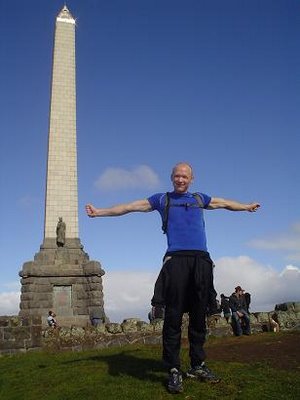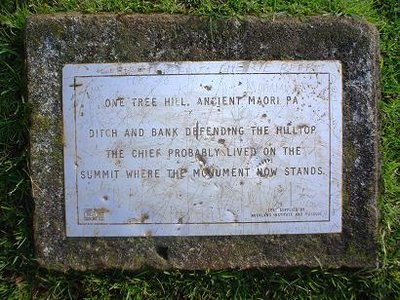One Tree Hill - a minor Sunday expedition
 A typical Eden Crescent-way of handling hangovers is going for a jog. So today, Mari & me went out on a 2 hour excursion to One Tree Hill, only 8 hours after finishing a cup of Karsk at the Smalosen's.
A typical Eden Crescent-way of handling hangovers is going for a jog. So today, Mari & me went out on a 2 hour excursion to One Tree Hill, only 8 hours after finishing a cup of Karsk at the Smalosen's.One Tree Hill is a 182 metre volcanic peak located in Auckland, New Zealand. The suburb which is built around the base of the hill is also called One Tree Hill. The hill is also known under its Maori name Maungakiekie, which translates to 'hill of the kiekie vine'. The mountain and its surrounds were home to the Wai o Hua tribe, since the early 1700s and probally before that time. Other Maori tribes in the Auckland area can also trace their ancestry to the Mountain.
On the summit of the hill is the grave of Sir John Logan Campbell surmounted by an obelisk, and until recently a Radiata pine tree. This tree (one of two pines) had been planted to replace a sacred Maori Totara tree, the tree which had given Maungakiekie its English name. The Totara was cut down by a white settler in 1852 for firewood. The obelisk was constructed in accordance with the wishes and provisions in John Campbell's will to commemorate his admiration for the Maori people. Before it stands a bronze statue of a Maori warrior.
The stone Obelisk was completed by 1940 – the centennial year of the signing of the Treaty of Waitangi but the unveiling of the Obelisk was delayed until 24 April 1948, after World War II was over, in keeping with Maori custom of not holding such ceremonies during a time of bloodshed.
 There were initially two pines. However, in the early 1960s during a Scout Jamboree, a group of overseas Boy Scouts cut down one of them. The remaining tree was attacked with chainsaws twice by Maori protesters. The final attack left the tree unable to recover and so was removed on October 26, 2000, due to the risk of it dying and falling down. A new nickname "No Tree Hill" soon became popular.
There were initially two pines. However, in the early 1960s during a Scout Jamboree, a group of overseas Boy Scouts cut down one of them. The remaining tree was attacked with chainsaws twice by Maori protesters. The final attack left the tree unable to recover and so was removed on October 26, 2000, due to the risk of it dying and falling down. A new nickname "No Tree Hill" soon became popular.One Tree Hill after the removal of the "One Tree"The hill's scoria cones erupted 20,000 - 30,000 years ago, creating lava flows that covered an area of 20 square kilometres. The summit provides views across the Auckland area, and allows visitors to see both of Auckland's Harbours.

0 Comments:
Post a Comment
Subscribe to Post Comments [Atom]
<< Home